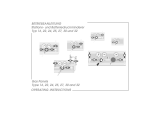Honeywell BA295D-4WHS Installation Instructions Manual
- Category
- Sanitary ware
- Type
- Installation Instructions Manual
This manual is also suitable for
Honeywell BA295D-4WHS is a system separator used to protect drinking water from contamination caused by negative pressure in the pipework system. It can be used for outside taps, as it should be installed in a frost-proof location, or directly under the distributor or water tab. The device is equipped with a strainer which prevents the ingress of dirt and other impurities. It is recommended to install a fine filter upstream, if the water is heavily polluted, to further ensure the correct function of the device.
Honeywell BA295D-4WHS is a system separator used to protect drinking water from contamination caused by negative pressure in the pipework system. It can be used for outside taps, as it should be installed in a frost-proof location, or directly under the distributor or water tab. The device is equipped with a strainer which prevents the ingress of dirt and other impurities. It is recommended to install a fine filter upstream, if the water is heavily polluted, to further ensure the correct function of the device.










-
 1
1
-
 2
2
-
 3
3
-
 4
4
-
 5
5
-
 6
6
-
 7
7
-
 8
8
-
 9
9
-
 10
10
Honeywell BA295D-4WHS Installation Instructions Manual
- Category
- Sanitary ware
- Type
- Installation Instructions Manual
- This manual is also suitable for
Honeywell BA295D-4WHS is a system separator used to protect drinking water from contamination caused by negative pressure in the pipework system. It can be used for outside taps, as it should be installed in a frost-proof location, or directly under the distributor or water tab. The device is equipped with a strainer which prevents the ingress of dirt and other impurities. It is recommended to install a fine filter upstream, if the water is heavily polluted, to further ensure the correct function of the device.
Ask a question and I''ll find the answer in the document
Finding information in a document is now easier with AI
in other languages
- Deutsch: Honeywell BA295D-4WHS
Related papers
-
Honeywell BA295STN-11-2C Owner's manual
-
Honeywell BA195 MINIBA Owner's manual
-
Honeywell BA295STN Owner's manual
-
Honeywell BA295I Owner's manual
-
Honeywell BA295 Owner's manual
-
Honeywell BA298I-F Owner's manual
-
Honeywell AEL Owner's manual
-
Honeywell NK 295C Owner's manual
-
Honeywell CA 195 Owner's manual
-
Honeywell D17P Owner's manual
Other documents
-
Gossen MetraWatt SECULOAD Owner's manual
-
 Puregas PMD Operating instructions
Puregas PMD Operating instructions
-
Truma Combi 6 Operating Instructions Manual
-
GMC G-SECULO-N Owner's manual
-
GCE 2-/4- PORT SHUT-OFF VALVE Operating instructions
-
resideo Braukmann R295SA Installation Instructions Manual
-
Conel CLEAR FILL Operating Instructions Manual
-
clage SA-DX2 Owner's manual
-
Gossen MetraWatt SECULIFE ST Important information
-
Parkside PHD 135 A1 Translation Of The Original Instructions










